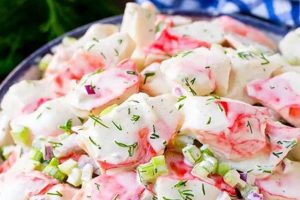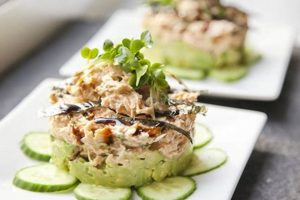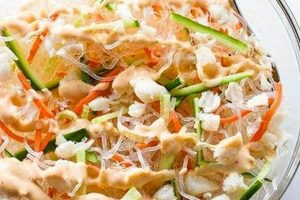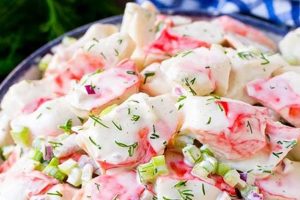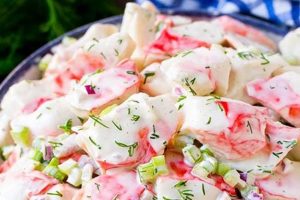Recipes using imitation crab meat offer a budget-friendly and convenient alternative to traditional crab meat in salads. These recipes typically combine shredded imitation crab with mayonnaise, celery, onion, and various seasonings. A simple example includes diced celery and onion mixed with imitation crab, mayonnaise, a dash of Dijon mustard, and a sprinkle of paprika.
The affordability and accessibility of imitation crab contribute to the popularity of these recipes. Using imitation crab allows for a wider audience to enjoy a crab-flavored salad experience, especially in regions where fresh crab is expensive or unavailable. Furthermore, the longer shelf life of imitation crab compared to fresh crab reduces the risk of spoilage, making it a practical choice for meal preparation. Historically, imitation crab, also known as surimi, has roots in East Asian cuisine, where the technique of processing white fish into various shapes and flavors has been practiced for centuries.
This exploration of imitation crab salad recipes will delve into variations, including ingredient substitutions, flavorful additions, and presentation tips for both casual and more formal dining occasions. It will also offer guidance on selecting high-quality imitation crab and provide nutritional information.
Tips for Crafting Delicious Imitation Crab Salad
Achieving optimal flavor and texture in imitation crab salad involves attention to ingredient selection and preparation techniques. The following tips offer guidance for creating a satisfying culinary experience.
Tip 1: Choose High-Quality Imitation Crab: Opt for imitation crab sticks with a firm texture and a delicate, slightly sweet flavor. Avoid products with an overly fishy odor or a mushy consistency.
Tip 2: Thaw and Drain Thoroughly: Properly thawing and draining the imitation crab removes excess moisture, preventing a watery salad. Pat the crab dry with paper towels after draining.
Tip 3: Enhance Flavor with Seasonings: Elevate the salad’s flavor profile with seasonings like Old Bay, paprika, dill, or lemon juice. A touch of Dijon mustard adds complexity.
Tip 4: Add Textural Variety: Incorporate finely diced celery, red onion, or water chestnuts for a satisfying crunch. Chopped fresh herbs like parsley or chives provide a fresh element.
Tip 5: Balance the Mayonnaise: Use enough mayonnaise to bind the ingredients without creating an overly creamy texture. Start with a smaller amount and add more as needed.
Tip 6: Chill Before Serving: Chilling the salad for at least 30 minutes allows the flavors to meld and enhances the overall experience. This step also firms the salad, making it easier to serve.
Tip 7: Consider Creative Presentations: Serve the salad on lettuce cups, crackers, or as a sandwich filling. Garnish with fresh herbs, lemon wedges, or a sprinkle of paprika for an appealing presentation.
By following these tips, one can create an imitation crab salad that is both flavorful and visually appealing. Attention to detail ensures a dish that rivals traditional crab salad in taste and satisfaction.
These preparation tips provide a solid foundation for exploring variations and customizing the recipe to individual preferences.
1. Ingredients
Ingredient selection significantly impacts the final quality and character of imitation crab salad. The interplay of components determines the overall flavor profile, texture, and nutritional value. Careful consideration of each ingredient contributes to a balanced and enjoyable culinary experience. For example, using high-quality imitation crab meat with a firm texture and subtle sweetness establishes a favorable foundation. Conversely, opting for lower-quality imitation crab might result in a fishy taste or mushy consistency, detracting from the overall enjoyment. The type of mayonnaise also plays a crucial role, influencing both flavor and richness. Traditional mayonnaise contributes a creamy texture and tangy flavor, while low-fat or vegan alternatives offer lighter options with varying flavor profiles.
Beyond the core ingredients, supplementary components contribute complexity and textural contrast. Finely diced celery and red onion provide a refreshing crunch, while fresh herbs like dill or parsley introduce aromatic notes. Seasonings such as Old Bay, paprika, or lemon juice further enhance the flavor profile, offering opportunities for customization. The quantity and balance of these ingredients determine the final taste and overall appeal. For instance, excessive mayonnaise can overpower the delicate crab flavor, while insufficient seasoning might result in a bland salad. Understanding these relationships allows for informed choices tailored to individual preferences.
Ingredient selection extends beyond flavor and texture to encompass nutritional considerations. Imitation crab salad can be a source of protein and omega-3 fatty acids, depending on the specific brand used. However, it can also be high in sodium, particularly if prepared with conventional mayonnaise and added seasonings. Opting for low-sodium alternatives and incorporating fresh vegetables like chopped bell peppers or cucumbers can enhance the nutritional value. This awareness empowers individuals to make informed decisions aligned with dietary goals and health consciousness. Therefore, a comprehensive understanding of ingredients is paramount for creating a delicious, satisfying, and potentially nutritious imitation crab salad.
2. Preparation
Preparation methods significantly influence the final texture, flavor, and overall quality of imitation crab salad. Proper techniques ensure optimal ingredient integration and enhance the sensory experience. From thawing and draining the imitation crab to combining ingredients and chilling the mixture, each step contributes to the final product.
- Thawing and Draining:
Proper thawing prevents a watery salad. Imitation crab should be thawed completely in the refrigerator and thoroughly drained to remove excess moisture. Patting the crab dry with paper towels further reduces moisture and ensures a desirable texture.
- Ingredient Incorporation:
Gentle mixing prevents the imitation crab from breaking down and maintains its delicate texture. Ingredients should be combined until evenly distributed, avoiding overmixing, which can lead to a mushy consistency. The order of ingredient addition can also influence the final result, particularly when incorporating seasonings and dressings.
- Chilling and Resting:
Chilling allows the flavors to meld and develop fully. After combining all ingredients, the salad should be refrigerated for at least 30 minutes before serving. This chilling period also firms the salad, making it easier to handle and serve while enhancing the overall dining experience.
- Portioning and Serving:
Appropriate portioning contributes to a visually appealing presentation. Whether served on lettuce cups, crackers, or as a sandwich filling, the portion size should complement the accompanying elements. Garnishing with fresh herbs or a sprinkle of paprika adds a final touch and enhances the visual appeal.
These preparation techniques, when executed correctly, ensure a well-balanced and flavorful imitation crab salad. Attention to detail throughout the process optimizes the combination of textures and flavors, resulting in a satisfying culinary experience. From initial thawing to final presentation, careful preparation elevates this dish beyond a simple mixture of ingredients into a carefully crafted culinary creation.
3. Flavor Profiles
Flavor profiles play a crucial role in defining the character and appeal of imitation crab salad. The careful balance of ingredients and seasonings determines whether the salad leans toward classic, zesty, or spicy profiles. Understanding these profiles allows for customization and caters to a broader range of palates.
- Classic:
The classic profile emphasizes the delicate sweetness of imitation crab meat. Traditional ingredients like mayonnaise, celery, and onion create a familiar and comforting flavor. A touch of Old Bay seasoning enhances the subtle crab flavor without overpowering it. This profile provides a balanced and widely appealing taste experience.
- Zesty:
Zesty profiles incorporate bright, acidic elements that contrast with the richness of the mayonnaise. Lemon juice, Dijon mustard, and chopped fresh dill contribute a tangy and refreshing dimension. This profile adds complexity and appeals to those seeking a lighter, more vibrant flavor.
- Spicy:
Spicy profiles introduce heat and complexity through the addition of ingredients like sriracha, chopped jalapeos, or a dash of cayenne pepper. These elements provide a warming sensation and contrast with the coolness of the other ingredients. This profile offers a bolder, more adventurous taste experience.
- Regional Variations:
Regional influences can inspire unique flavor profiles. For example, incorporating Old Bay seasoning reflects a classic Maryland-style preparation, while adding wasabi and soy sauce creates an Asian-inspired twist. Exploring regional variations offers opportunities for culinary creativity and expands the possibilities within the realm of imitation crab salad.
By understanding and manipulating these flavor profiles, one can craft imitation crab salads tailored to specific preferences and occasions. Whether aiming for a familiar comfort or a bold culinary adventure, exploring flavor profiles allows for a personalized and satisfying culinary experience.
4. Serving Suggestions
Serving suggestions transform imitation crab salad from a simple mixture into an enticing culinary presentation. The manner of presentation influences not only visual appeal but also the overall dining experience. Considerations range from casual to formal, reflecting the versatility of this dish.
- Casual Gatherings:
For casual settings, serving imitation crab salad on crackers, in lettuce cups, or as a sandwich filling offers convenience and ease of consumption. These options are ideal for picnics, potlucks, and informal gatherings where simplicity and portability are valued. Crackers provide a crispy contrast to the creamy salad, while lettuce cups offer a lighter, refreshing alternative. Sandwiches, using croissants or other breads, transform the salad into a satisfying meal option.
- Formal Presentations:
Elevating imitation crab salad for more formal occasions involves attention to detail and presentation. Small, elegant portions served on endive spears or cucumber rounds create an aesthetically pleasing appetizer. Garnishing with fresh herbs, a sprinkle of paprika, or a drizzle of balsamic glaze adds sophistication and visual appeal. These presentations highlight the delicate flavors of the salad while showcasing culinary artistry.
- Accompaniments and Pairings:
Thoughtful accompaniments enhance the overall dining experience. Serving imitation crab salad alongside fresh fruit, a light green salad, or a crusty baguette complements the flavors and textures. Beverage pairings, such as a crisp white wine or iced tea, further elevate the meal. These pairings create a balanced and harmonious culinary experience.
- Creative Adaptations:
Imitation crab salad can be incorporated into various dishes beyond traditional presentations. Using it as a filling for deviled eggs or adding it to avocado halves creates unique appetizers. Incorporating the salad into wraps or using it as a topping for baked potatoes offers creative meal options. These adaptations showcase the versatility of imitation crab salad and expand its culinary potential.
From casual snacks to elegant appetizers, the versatility of imitation crab salad allows for diverse serving suggestions. Considering the occasion and desired level of formality informs the chosen presentation, enhancing the overall dining experience. By exploring these various options, one can elevate imitation crab salad from a simple dish to a culinary centerpiece.
5. Nutritional Considerations
Nutritional considerations are relevant when evaluating recipes utilizing imitation crab meat. While offering a cost-effective and convenient alternative to fresh crab, imitation crab’s nutritional profile differs significantly and warrants careful consideration, especially regarding sodium content, protein sources, and potential additives.
- Sodium Content
Imitation crab meat often contains high levels of sodium due to its processing. This sodium content can contribute to exceeding recommended daily intake limits, posing potential health risks for individuals sensitive to sodium, such as those with hypertension. Comparing sodium levels across various brands and opting for lower-sodium varieties can mitigate this concern. Additionally, careful monitoring of other ingredients’ sodium content, such as mayonnaise and seasonings, allows for better overall sodium management within the recipe.
- Protein Source
While imitation crab provides protein, it primarily derives from processed white fish (surimi) rather than the whole muscle meat of crab. This distinction results in a different protein composition and potentially lower bioavailability compared to fresh crab. Understanding this difference allows for informed dietary choices, particularly for individuals seeking specific protein sources or those with dietary restrictions related to processed foods.
- Additives and Fillers
Imitation crab often contains additives like starch, sugar, and flavor enhancers to mimic the texture and taste of real crab. These additives can contribute to increased carbohydrate and sugar content, which should be considered for individuals monitoring these nutrients. Examining ingredient lists and selecting products with minimal additives offers greater dietary control and aligns with preferences for whole-food ingredients.
- Omega-3 Fatty Acids
Some imitation crab products may contain added omega-3 fatty acids, aiming to replicate the nutritional benefits of fresh crab. However, the type and amount of these added omega-3s can vary significantly. Evaluating nutritional labels and comparing products allows consumers to assess the actual omega-3 content and make informed choices aligned with their dietary needs.
Careful consideration of these nutritional factors allows for informed choices regarding imitation crab consumption. Balancing the convenience and affordability of imitation crab with its nutritional profile enables individuals to incorporate it into their diets mindfully, aligning choices with health goals and dietary preferences. Considering portion sizes and incorporating fresh, nutrient-rich ingredients into imitation crab salad recipes can further enhance the nutritional value of the overall meal.
Frequently Asked Questions
This section addresses common inquiries regarding the use of imitation crab in salad recipes, providing factual and concise information to guide culinary choices.
Question 1: What is imitation crab meat made of?
Imitation crab, also known as surimi, primarily consists of processed white fish, typically Alaskan Pollock, combined with starch, sugar, flavorings, and colorings to mimic the flavor, texture, and appearance of real crab meat.
Question 2: Is imitation crab healthy?
Imitation crab can be a source of protein and omega-3 fatty acids, but it is often high in sodium and may contain additives. Nutritional value varies depending on the brand. Moderation and ingredient awareness are key to incorporating it into a balanced diet.
Question 3: How can sodium intake be reduced in imitation crab salad?
Opting for lower-sodium imitation crab brands, using low-sodium mayonnaise, and minimizing added salt in the recipe can significantly reduce overall sodium content. Incorporating fresh vegetables also helps balance the sodium density.
Question 4: Can imitation crab be cooked?
Imitation crab is pre-cooked during processing. Further cooking is unnecessary and may negatively impact texture, potentially resulting in a rubbery consistency. It is best served chilled or at room temperature.
Question 5: How should imitation crab be stored?
Unopened imitation crab should be stored in the refrigerator according to package instructions. Once opened, it should be kept refrigerated in an airtight container and consumed within a few days to maintain optimal quality and prevent spoilage.
Question 6: What are suitable alternatives to mayonnaise in imitation crab salad?
Greek yogurt, plain yogurt mixed with a small amount of olive oil, or avocado mayonnaise offer healthier alternatives to traditional mayonnaise, reducing fat and calorie content while maintaining a creamy texture.
Understanding these aspects of imitation crab allows for informed culinary decisions based on individual dietary needs and preferences.
This concludes the frequently asked questions section. The following sections will provide specific recipe variations and detailed instructions for creating delicious and personalized imitation crab salads.
Crab Salad Recipe Imitation Crab Salad
Exploration of recipes utilizing imitation crab meat reveals a versatile and accessible approach to enjoying crab-flavored salads. Careful ingredient selection, including high-quality imitation crab and complementary seasonings, contributes significantly to achieving desirable flavor profiles. Proper preparation techniques, such as thorough thawing and gentle mixing, ensure optimal texture and prevent a watery consistency. Nutritional considerations, particularly regarding sodium content, inform mindful consumption and recipe adaptation. Serving suggestions range from casual to elegant presentations, showcasing the adaptability of imitation crab salad for diverse occasions.
Ultimately, imitation crab salad offers a budget-friendly and convenient alternative to traditional crab salad, allowing wider access to this culinary experience. Continued exploration of flavor profiles and creative adaptations promises further evolution and enjoyment of this versatile dish.

